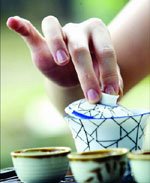Well, I'm still in China, but now I can finally post some new material on here. It's been awhile. Things have been busy here in Fujian. We didn't have rain for like over 2 months during September and October and a part of November. There was just thick dust on all the tree leaves. It gets like that here - lots of dust in the homes, on buildings, and on trees. You can literally see the dust caked on the leaves.
And, if you see dust on the leaves, then, if it rains you should avoid walking under the leaves - otherwise you'll end up with a dirty mess on your clothes.
Since there's so much dust, it seems to me that the leaves on the tea trees would be covered in dust if there's no rain too. But they would wash that off before processing anyway.
But, still, just gives another reason why you should rinse your leaves when you brew tea. They might have all kinds of accumulated dust on them - at some point.
I'm living in Southern Fujian, and Anxi is not very far from here - where Tieguanyin comes from - and other kinds of teas - like Benshan, Maoxie, and Huangjingui.
Everyone here drinks Tieguanyin, it's like the king of wulong teas, especially when talking about southern Fujian teas.
Yes, Tieguanyin is king, and everyone drinks it exclusively. They don't even look at other kinds of teas. That's how so highly regarded it is. I drank some of the autumn pick, and it was pretty good. But, not having rain for 2 months means the crop is not as perfect as it could have been - when compared to prior years. But it's still very good though.
Immortal's Palm Tea
-
by STEVEN D. OWYOUNG
AUTHOR'S NOTE: *This essay is dedicated to Frank Hadley Murphy, author of
The Spirit of Tea, for his kind introduction to the poet Li B...
14 years ago


2 comments:
i'm really confused on the use of the word TGY...
is that the green or the black/oxidized oolong?
TGY just means tieguanyin. Typcially now, TGY is a lightly fermented oolong, with green leaves and a highly floral scent. As it stands today, in Fujian, this is the most popular sought-after kind of TGY. And it's also the most expensive. This type of TGY is know as "Qing Xiang" tie guan yin.
Then, there is "nong xiang" tieguanyin, which has a darker appearance to the leaves, owing to a heaving oxidized tea. And it doesn't have that floral scent that Qingxiang tieguanyin has. And the color of the infusion is darker too.
Post a Comment